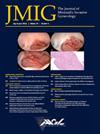Identification and Resection of Bladder Endometriosis
IF 3.5
2区 医学
Q1 OBSTETRICS & GYNECOLOGY
引用次数: 0
Abstract
Study Objective
To demonstrate surgical management of bladder endometriosis.
Design
Surgical Video.
Setting
Academic medical center.
Patients or Participants
A 29-year-old female with a history of anxiety presenting with dysmenorrhea, bladder spasms, and deep and superficial dyspareunia. MRI showed a 2.5 cm hypointense focus between the inferior uterine body and superior aspect of the urinary bladder.
Interventions
On diagnostic laparoscopy, the patient was found to have deeply infiltrating endometriosis in the anterior cul-de-sac. On cystoscopy, a bulging mass concerning for endometriosis was visible in the bladder but did not invade the bladder mucosa. The patient was scheduled for a joint case with urology for resection of the bladder lesion. At the beginning of the case, repeat cystoscopy redemonstrated the mass and bilateral ureteral stents were placed. On robotic assisted laparoscopy, the mass was found to be densely adhered to the anterior aspect of the uterus and the vesicovaginal septum. Attempts were made to dissect the endometriotic nodule off the detrusor muscle but, due to the extent of muscle invasion, the decision was made to incise the bladder mucosa. An intentional cystotomy was made and carried out circumferentially to remove the entirety of the lesion. Cystotomy was repaired in two layers with 2-0 vicryl in running fashion. A leak test confirmed watertight closure.
Measurements and Main Results
Following resection of bladder lesion, patient reported complete resolution of her dysmenorrhea, bladder spasms, and dyspareunia. Cystogram two weeks later was negative for extravasation.
Conclusion
Bladder endometriosis is a common variant of deep infiltrating endometriosis. A partial cystectomy is a safe and effective treatment option.
膀胱子宫内膜异位症的识别与切除
研究目的展示膀胱子宫内膜异位症的手术治疗.设计手术视频.设置学术医疗中心.患者或参与者一名29岁的女性,有焦虑病史,表现为痛经、膀胱痉挛以及深浅不一的排便困难。核磁共振成像显示,在子宫体下部和膀胱上部之间有一个2.5厘米的低密度病灶。在诊断性腹腔镜检查中,发现患者的子宫内膜异位症在前穹窿处浸润较深。在膀胱镜检查中,膀胱内可见子宫内膜异位症的隆起肿块,但未侵犯膀胱粘膜。患者被安排与泌尿科联合进行膀胱病灶切除术。病例开始时,膀胱镜再次显示肿块,并放置了双侧输尿管支架。在机器人辅助腹腔镜检查中,发现肿块与子宫前部和膀胱阴道隔紧密粘连。医生试图将子宫内膜异位结节从逼尿肌上剥离,但由于肌肉受侵犯的程度很深,最终决定切开膀胱粘膜。手术中有意进行了膀胱切开术,并从周缘切除了整个病灶。膀胱切口用 2-0 vicryl 进行两层修复。测量和主要结果膀胱病变切除后,患者的痛经、膀胱痉挛和排便困难症状完全消失。结论膀胱子宫内膜异位症是深部浸润性子宫内膜异位症的一种常见变异。膀胱部分切除术是一种安全有效的治疗方法。
本文章由计算机程序翻译,如有差异,请以英文原文为准。
求助全文
约1分钟内获得全文
求助全文
来源期刊
CiteScore
5.00
自引率
7.30%
发文量
272
审稿时长
37 days
期刊介绍:
The Journal of Minimally Invasive Gynecology, formerly titled The Journal of the American Association of Gynecologic Laparoscopists, is an international clinical forum for the exchange and dissemination of ideas, findings and techniques relevant to gynecologic endoscopy and other minimally invasive procedures. The Journal, which presents research, clinical opinions and case reports from the brightest minds in gynecologic surgery, is an authoritative source informing practicing physicians of the latest, cutting-edge developments occurring in this emerging field.

 求助内容:
求助内容: 应助结果提醒方式:
应助结果提醒方式:


